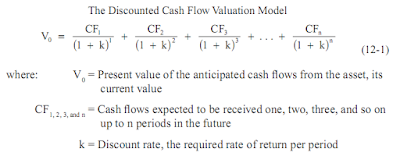The primary financial goal of financial managers is to
maximize the market value of their firm. It follows, then, that financial
managers need to assess the market value of their firms to gauge progress.
Accurate business valuation
is also a concern when a corporation contemplates selling securities to
raise long-term funds. Issuers want to raise the most money possible from selling
securities. Issuers lose money if they undervalue their businesses. Likewise, would-be
purchasers are concerned about businesses’ value because they don’t want to pay
more than what the businesses are worth.
A General Valuation Model
The value of a business depends on its future earning power.
To value a business then, we consider three factors that affect future
earnings:
• Size of cash lows
• Timing of cash
lows
• Risk
These three factors
also determine the
value of individual
assets belonging to a
business, or interests
in a business,
such as those possessed by
bondholders and Stockholders.
We examined how risk factors affect an investor’s required
rate of return. We learned hat time value of money calculations can determine an
investment’s value, given the size and timing of the cash lows. We learned how
to evaluate future cash lows.
Financial managers determine the value of a business, a
business asset, or an interest in a business by finding the present value of the future cash lows that
the owner of the business, asset, or interest could expect to receive.
For example, we can calculate a bond’s value by taking the sum of the present
values of each of the future cash lows from the bond’s interest and principal
payments. We can calculate a stock’s value by taking the sum of the present
values of future dividend cash low payments.
Analysts and investors use a general valuation model to
calculate the present value of future cash lows of a business, business asset,
or business interest. This model, the discounted cash low model (DCF), is a
basic valuation model for an asset that
is expected to generate cash payments in the form of cash earnings,
interest and principal payments, or dividends. The DCF equation is shown in
Equation 12-1:
The DCF model values an asset by calculating the sum of the
present values of all expected future cash lows.
The discount rate in Equation 12-1 is the investor’s
required rate of return per time period, which is a function of the risk of the
investment. Recall from Chapter 7 that the riskier the security, the higher the
required rate of return.
The discounted cash
low model is easy
to use if we know the
cash lows and discount rate. For
example, suppose you were considering purchasing a security that entitled you
to receive payments of $100 in one year, another $100 in two years, and $1,000
in three years. If your required rate of return for securities of this type
were 20 percent, then we would calculate the value of the security as follows:


Having a reliable estimate of the value of your business puts you in a strong negotiating position in any of these situations. Business Valuation Reports will arm you with the market knowledge and information required to make the right decisions regarding the future of your business.
ReplyDeleteCompany appraisal Seattle